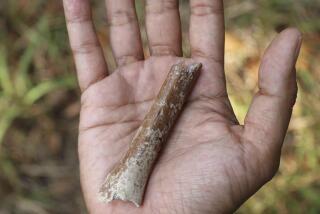Bone Find in Africa Leads to New View of Ancestor of Humans
- Share via
The earliest known direct ancestor of humans was a tool-user who roamed the plains of East Africa 1.8 million years ago and was shorter and more ape-like than previously believed, Berkeley scientists said in a paper published today.
Their finding suggests that the evolution of early man from a long-armed tree climber to a short-armed, more human-like forager and hunter occurred over a surprisingly brief period of 200,000 years, experts said.
These conclusions result from the discovery of limb bones associated with a skull of Homo habilis , the first proto-human or hominid to have a significantly larger brain than its predecessors.
The discovery provides the first certain picture of the size and body structure of this species, said the anthropological team headed by Donald C. Johanson of the Institute of Human Origins in Berkeley and Tim D. White of the University of California, Berkeley. Their paper appears in the British journal Nature.
“It adds a lot to the way we look at things,” said anthropologist C. Loring Brace of the University of Michigan. “It gives us a better perspective on early hominids, who are in many respects transitional between apes and early humans.”
Discovered by Leakey
H. habilis-- “handyman” or “tool-using man”--was discovered in the early 1960s in the fossil-rich Olduvai Gorge area of northern Tanzania by the eminent anthropologist Louis S. B. Leakey.
Leakey and others never found a complete skeleton of H. habilis. Arm and leg bones from the same period were often found near skulls, but they could not be definitively linked to the skulls because at least two other species of hominids lived in the same area at the same time.
Those two species, Australopithecus boisei and A. robustus , shared a common ancestor with H. habilis but represented separate evolutionary lines that were destined to become extinct. All three species were primarily vegetarians who probably avoided each other as much as possible.
Many anthropologists think that the tool-using ability of H. habilis allowed it to dominate the other two and eventually evolve, around 1.6 million years ago, into the much more manlike Homo erectus.
Johanson and White discovered the new fossil, called OH-62, a few hundred yards from where Leakey’s team had made its first discovery 25 years earlier. The Berkeley scientists were conducting a preliminary survey of the area last summer when they noticed two arm bones lying on the surface.
In the next five weeks, the team collected about 18,000 bone and tooth fragments, including 302 pieces of the hominid. The other fossils included ancient mammals, birds and reptiles.
‘Very Old Lady’
The fossil is of an old woman. “The teeth are worn right down to the gums, and in one case are worn into the bone,” said anthropologist Henry McHenry of the University of California, Davis, who has seen the fossils. “This is a very old lady, about the oldest specimen known.”
The 3-foot, 4-inch woman, McHenry said, “is shockingly small, way below anything found up to now. . . . It is clearly a member of our genus, H. habilis , and that indicates that the female was much smaller than the male. My estimate is that the male of the species has about twice the body size.” The male’s brain was also about 50% larger.
Even more surprising, said anthropologist Eric Delson of Lehman College of the City University of New York, were the limb proportions. The woman’s arms probably hung down to her knees. H. habilis was thus not yet well adapted to life on the plains, where heights and the ability to stand upright were important for spotting danger at a distance.
OH-62 is so surprising, White said in a telephone interview, because Leakey had found the fossil of a young H. erectus , dated from 1.6 million years ago, that was nearly six feet tall and that had “modern” limb proportions. “This implies a dramatic, abrupt evolutionary shift,” he said.






